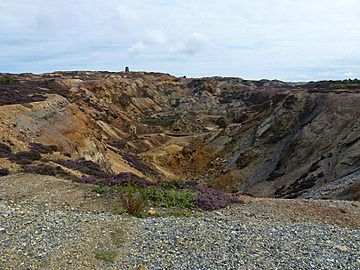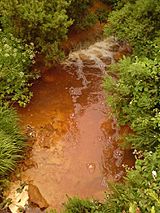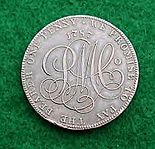Parys Mountain facts for kids
Quick facts for kids Parys Mountain |
|
|---|---|

Parys Mountain
|
|
| Highest point | |
| Elevation | 147 m (482 ft) |
| Prominence | 66 m (217 ft) |
| Geography | |
| Location | Anglesey, United Kingdom |
| OS grid | SH445905 |
| Topo map | OS Landranger 114 |
Parys Mountain (which is called Welsh: Mynydd Parys in Welsh) is a mountain in north east Anglesey, Wales. It's famous for being the site of a very large copper mine. This mine was used a lot in the late 1700s.
Contents
Discovering Parys Mountain's Past
Parys Mountain was first mined for copper ore a very long time ago, during the early Bronze Age. This was nearly 4,000 years ago! We know this because old mining tools and debris were found in 2002. Later, people found hidden tunnels and rooms from these ancient mines. This makes Parys Mountain one of the few places in Britain that shows how metal mining started here.
Miners in the 1700s realized that people had mined here before them. They even found copper bars with Roman writing on them nearby.
In 1764, a man named Charles Roe was given permission to mine copper on the mountain for 21 years. Then, on March 2, 1768, a local miner named Rowland Pugh found a huge amount of copper ore, which was called the "Great Lode." For his amazing discovery, he received a bottle of whisky and a house he could live in for free!
Even though the copper ore at Parys Mountain wasn't the best quality, there was so much of it close to the surface that it was still very valuable. At first, miners dug shallow holes. Then, they started open-pit mining, which means digging a big hole from the surface. Finally, they dug underground tunnels and shafts.
The ore was broken into small pieces by hand. The best pieces were sent to places like Lancashire or Swansea in South Wales to be melted down. Other copper was separated and cleaned on the mountain using special kilns and furnaces. Miners also found a clever way to get pure copper by collecting it from the water that drained out of the mine. They used scrap iron in special ponds to do this.
Important chemical factories also grew around the mines. They used things found in the mountain, like ochre (a type of paint), sulphur, vitriol (a strong acid), and alum (used in many industries).
During the 1780s, Parys Mountain was the biggest copper mine in Europe. It supplied so much copper that it changed the world's copper market! The copper from this mine was used to cover the bottoms of British navy ships. This special covering stopped seaweed and barnacles from growing and protected the wood from tiny worms. This made the ships faster and easier to steer, and they could stay at sea for much longer without needing repairs.
Because there wasn't enough small money in the country, the Parys Mine Company even made its own coins between 1787 and 1793. These coins, called the Parys Penny or Anglesey Penny, were used to pay workers and by people all over the area. It's thought that about ten million pennies and half pennies were made!
A mineral called Anglesite was first found at the Parys copper mine in 1783. It was named after Anglesey in 1832.
Parys Mountain Today

Today, you can walk on a special trail around the mountain. From here, you can see Amlwch Port to the north and the Trysglwyn wind farm to the south. If you want to explore the old mine tunnels underground, you need to contact the Parys Underground Group.
Since 1988, a company called Anglesey Mining plc has found a lot more valuable metals in the western part of the mountain. They have plans to start mining again, hoping to dig up 350,000 tonnes of ore each year. This ore contains zinc, lead, copper, and even some silver and gold!
In the late 1990s, experts checked the mine's water systems. They found that a large underground lake, held back by a dam, was in bad shape. They worried the dam might break, which could flood parts of Amlwch and cause a lot of damage. The water in this underground lake was also very dirty, full of copper and other metals, and very acidic.
So, in 2003, they carefully drained the water, lowering the level by 70 meters. This took the pressure off the dam, and it could be removed safely. Draining the water also opened up many more tunnels and even connected to another old mine called Mona Mine. Exploring these newly opened sections was even filmed for a TV show called Extreme Archaeology!
Because the soil on the mountain has a lot of chemicals, not many plants grow there. But you can find some rare plants and special bacteria. The bare, heavily mined landscape gives the mountain a very unusual look. This unique appearance has been used as a filming location for science fiction movies and TV shows, like a scene in Mortal Kombat: Annihilation.
Because of the high chemical content in the water, strange cave formations called snottites grow in the passages that were once underwater.
Museum at Parys Mountain
Mynydd Parys is an important stop on the European Route of Industrial Heritage. This means it's recognized as a key place in Europe's industrial history.
How Parys Mountain Was Formed
The valuable metal deposits in Parys Mountain were formed by volcanoes. They are found where Ordovician and Llandovery epoch rocks meet. The ore is covered by a layer of volcanic rock called rhyolite.


